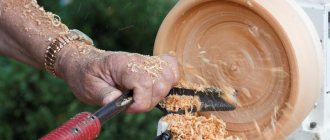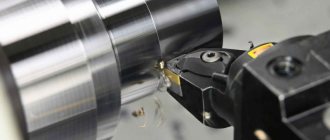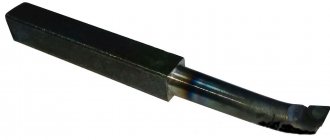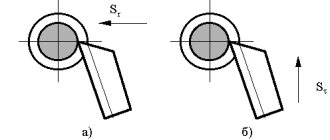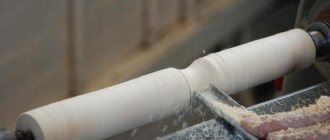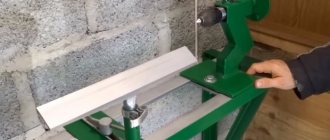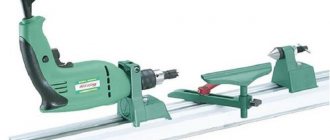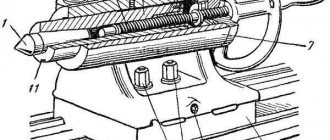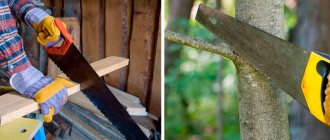SHARE ON SOCIAL NETWORKS
FacebookTwitterOkGoogle+PinterestVk
Wood cutters for a lathe are designed for processing wooden parts on a special machine, which are widely used for the manufacture of furniture or interior elements. The construction market offers a wide range of different types of tools, which are selected based on the scope of use and the material of the wooden workpiece. Everything you need to know about wood cutters can be found in this article.
Special cutters are used as tools for working with a lathe, which have long handles so that the master can hold the tool firmly in his hands
Wood cutters for a lathe: purpose and design of elements
The main purpose of wood turning tools is manual processing of a part rotating in a special machine. The lathe used for these purposes is designed to impart rotation to the body. Wooden blanks, which are initially round in shape, are mounted on a lathe using two clamps. One clamp is connected to an electric motor, which sets the part in motion.
The choice of the type of turning cutter, its sharpening and condition largely determines the possibility of certain operations and the manufacture of parts of the required configuration
Important! On the motor side, the fixation must be rigid so that rotational movements do not occur at idle.
The cutters, which are fixed to the rotating mechanism, perform processing of the rotating body. Depending on the strength, shape and sharpness of the cutter, marks are formed on the wooden workpiece. This also determines the shape of the workpiece.
The design of a lathe cutter consists of a working metal part and a wooden handle. The working element conventionally consists of a blade, body and shank. The blade consists of a front, back and pointed angle. The size of the sharpening angle depends on the material of the workpiece. Most often, craftsmen use sharp corners when working with wood. The body is the main part for which the turner holds the cutter on the armrest of the machine with his non-working hand. The shank is a narrowed part into which the body of the tool goes. It is on this that the handle of the turning tool is attached.
The handle structure consists of a base and a neck. The base is the larger part of the handle that the turner holds with his hand. The neck is represented by a small cylindrical part with a metal fastening ring. It is designed to prevent the handle from cracking while being pressed onto the shank of the working part.
Wood turning tools consist of a back corner, a pointed corner and a rake corner.
Various options and their purpose
The variety of cutting tools for wood when rotating on a lathe is very large. Experienced craftsmen create cutters of the shape they consider convenient for the implementation of individual tasks. Therefore, one personal cutter is not similar to another. However, there are standards for factory tools, some of which are basic, others highly specialized.
Reyer
This is one of the basic incisors. It can be recognized by its characteristic shape - the working part of the rail is not flat, but curved, forming a groove. Sharpening is done from the inside of the curve. They work with a rake, bringing it to the workpiece with the groove up.
Thanks to the shape of the blade, this cutter selects wood in a semicircle. Its longitudinally curved shape makes it very durable, making it well suited for rough turning of workpieces. With the help of a reyer you can also make smooth transitions and grooves with a semicircular profile.
Meysel
If a reyer is a relatively simple tool, which is intended primarily for rough, rough work, then a meisel is already much more difficult to use. It is unlikely that you will be able to master it in a couple of days of practice. This cutter is used already when the outlines of the wooden product are formed. However, for an experienced turner, the use of a meisel gives an even, smooth surface of wood of a given geometry.
The Meisel is a bit like a regular flat hammer chisel, but its blade is angled. Accordingly, the master must have at his disposal at least two meisels - left- and right-handed - in order to process mirrored areas.
Sharpening the meisel can be done either by beveling one side until it comes out flat, or by equally removing the metal layer from both sides. In this case, the width of the blade can reach up to 40 mm, and the bevel angle ranges from 60 to 75 degrees. When sharpening a cutting edge on both sides, the angle should be 20 – 25° on each side.
Shaped
After the main processing of the part in the headstocks has been completed, it is the turn of the figured cut. For this purpose, shaped cutters are used. They can have different shapes for turning grooves, grooves, and select grooves of complex shapes.
Klukarza.
The most common “styles” are:
- Klukarza. The shape of the cutter is similar to the reyer, but has a bend in the working part near the blade. Thanks to this shape, the cranberry can be used for small and complex work; it can reach places where tools with a straight working part cannot reach.
- Comb. It makes parallel grooves and grooves. With the proper level of skill, a thread is cut using a comb.
- Hook. Allows you to make an internal recess with a protruding edge, as well as various curved grooves.
- Crescent or dovetail. Used for turning round and faceted beads.
The process of turning a workpiece on a lathe significantly depends on the sharpening angle of the tool. Small angles (20 – 30°) are intended for fine work. They remove wood well, but if moved carelessly they can damage the workpiece or break themselves. Large angles (60 – 75°) are intended for rough work with hard rocks. They can remove less in one pass, but they are not afraid of knots and pressure created by the turner.
Types of wood turning tools
Today on the shelves of hardware stores you can find several types of woodworking tools for lathes: rakes, meisels, chisels, scrapers, trimming cutters, bevel cutters, hooks, rings, combs.
The main purpose of the rafter is the initial, rough, rough processing of the workpiece. The blade of the tool has a special design and is presented in the form of a semicircle. It can be made from a semicircular groove or a thick plate. Using a rayer, the workpiece can be given an approximate outline of the future product.
Meisel is used for finishing and giving the product its final shape. The tool can also be used to cut off the final product from the remains of the workpiece. The shape of a meiser is similar to a jamb knife and is represented by a plate with an oblique blade, sharpened on both sides at the same angle. Using a reyer and a meisel, you can perform turning work of medium complexity. The workpiece is processed along the outer surface. In certain cases, it is possible to work with the internal cavity of parts.
Meisel cutter: a) left-hand sharpening; b) double-sided sharpening; c) right-hand sharpening
Other types of turning cutters belong to the shaped group of products. Chisels are designed for turning smooth surfaces. The blade of the product has a special shape and sharpening. To give the workpiece relief, you can use a special chisel with a knurled roller. Scrapers can have straight or curved cutters, which is convenient for scraping flat or cylindrical wood. This tool can also be used for roughing wood.
Parting cutters have spoon-shaped blades, making it possible to create cups or other semicircular designs. Oblique incisors are represented by grooved chisels, concave chisels and semicircular incisors. The hook and ring are designed to create a cavity of any configuration in the workpiece. The comb is used to create carvings and apply decorative marks and grooves.
Types by functionality
When working on a lathe, it is necessary to have several types of cutters, since these tools, depending on the sharpening and shape, perform various functions, ranging from rough grinding to fine finishing of the finished product.
Rough stripping
A tool designed for such work contains a pair of working edges that mate with each other at an acute angle. This tool is safer than its radial counterparts.
Finish turning
Cutters of this functionality are needed to remove a small layer of chips. Using this tool, you cannot shape the finished product; you can only make the outer surface smooth. Finish turning tools have a tip angle with a right or left sharpening angle.
Shaped
The shaped type of cutter has a semicircular tip. It is designed to work with non-standard surfaces. The configuration of shaped cutters can be very different, depending on the surface being processed and its shape.
Cut-off
It is used only for a single process - cutting the finished product from the remnants of the workpiece.
Boring
These cutters are designed to remove excess material during processing of the product. There is a special ledge in the cutting area for such operations.
Round
Necessary for processing radius workpieces. The working part of such a tool may contain small technological cutters or be radius.
For internal turning
If the cutter is intended for internal turning, then a limiter must be installed on it to regulate the turning depth.
How to make wood cutters for a lathe with your own hands
Many craftsmen prefer not to purchase cutters in a store, but to make wood carving tools with their own hands. Meiser and reyer are easy to make. To do this, you can use waste material in the form of files and rasps. These products have the required dimensions, strength, material quality and steel grade. A sharpening machine is used to give the file the required shape. Then a turned handle equipped with a fastening ring is stamped onto the product.
Homemade turning cutters for wood processing: 1 - for deep processing, 2 - for clean processing, 3 - shaped turning, 6 - cutting off, 5 - boring, 6 - for turning balls, 7 - for end shaped turning, 8 - cutter with limiter
You can make wood cutters with your own hands from car springs or reinforcement bars. These materials have the necessary hardness. However, you must be extremely careful with this tool during its further use. The test should be carried out first on soft wood such as poplar or linden. Next, a visual inspection of the tool is carried out for cracks and chips. If they are missing, then homemade wood cutters for a lathe can be used for hardwood.
When making tools for working with wood, it is important to follow certain recommendations. The choice of body length should be based on the possibility of fully grasping it with the hand and resting on the armrest. Here you should also take into account the distance between the armrest and the workpiece and the margin for sharpening and wear. The optimal length is considered to be from 20 to 30 cm. The length of the shank should be calculated in such a way as to eliminate the possibility of it being pulled out of the handle.
Helpful advice ! If files or rasps are used to make cutters, the length of the shank should be increased by 1.5-2 times.
Each person will be able to make homemade cutters that will become an indispensable assistant for surface treatment
The thickness of the working part of the tool must be calculated taking into account to prevent its damage during turning of the workpiece. Therefore, this value should be maximum, which is especially important for large-diameter workpieces. The cutter handle must be at least 25 cm. If this value is smaller, then when performing the turning process the tool will be difficult to hold in your hands, which will negatively affect the quality of the work. You can study in more detail the process of how to make a wood cutter with your own hands on specialized websites on the Internet.
General rules and safety precautions
Principles of safe work on a wood lathe:
- You should work in special clothing, which must be put on before turning on the machine;
- there should be no unnecessary objects or tools on the machine;
- be sure to check the workpiece for knots and cracks;
- check the serviceability of the cutting tool and its sharpness;
- wear safety glasses;
- when working, apply the cutter to the part only when the shaft reaches full rotation speed;
- do not tilt your head close to the machine;
- take measurements of the part only after stopping rotation;
- You must not leave the machine while it is working.
After work, it is recommended to remove chips with a special brush.
When working on a wood lathe, you need a whole set of different cutters. Each of them performs its own function and is designed for a specific job. Such cutters can be purchased in stores or made independently.
Sharpening wood cutters for a lathe
The quality of the processed workpiece largely depends on proper sharpening, namely on the geometry of the turning cutter. The sharpening angle is selected individually by each craftsman depending on his own skills, the hardness of the wood, the quality of the working tool, and the final desired type of the surface being processed.
For a beginning craftsman, the sharpening angle of the chisel and meiser should be 40 degrees relative to the working surface and relative to each side of the blade. For a reyer this value is 50-60 degrees. With increasing skill level, the sharpening angle can decrease to 20-35. The sharpening process is carried out on a special machine for sharpening turning tools, which is equipped with a set of wheels of various grain sizes and a velvet bar for manually straightening the blade.
Before sharpening the cutter, you need to properly fix it in the mandrel.
Helpful advice! A turner's tool set must contain cutters of the same type, uniform size, and having different sharpening angles. This will significantly speed up the work of the specialist and extend the service life of the products, since there will be no need to constantly resharpen the blade, depending on the type of workpiece being processed.
Tools with a sharper sharpening angle are used for rough cutting and hardwood workpieces. Cutting tools with sharper angles allow for better processing of the workpiece surface. It is used to speed up the turning process. However, in this case, the likelihood of damage to the blade and chipping of the workpiece increases. In addition, editing and sharpening wood cutters with sharp corners will be performed more often than elements with obtuse corners.
The approximate sharpening angle of the blade is formed at the stage of manufacturing turning tools before the hardening process begins. After the end of the heat treatment, sharpening is carried out using an abrasive wheel and is completed on a velvet block by hand finishing.
To prevent the appearance of burrs and chips on turned parts, it is important to use correctly sharpened cutters
When and how should you sharpen?
The quality of the finished product processed with this cutter depends on the geometry of the turning cutter. For a beginning turner, the sharpening angle of the chisel and meisel should be 40°. For reyer – 50-60°.
There are two sharpening methods:
- Manual. It is characterized by low productivity and a complete absence of mechanical labor. It is unlikely to achieve the desired result with high accuracy.
- Mechanical method using special machines with a stone for removing metal.
The manual method is most often used when it is necessary to sharpen a slightly worn tool in a short time. The machine helps to remove defects that appear as a result of operation.
Which wood turning tools should I buy?
To work on a woodworking machine, it is better to have all the necessary tools. For this purpose, it is better to purchase not just one unit, but a whole set of elements. One of the popular and sought-after options is a set of turning wood cutters Enkor 10430. Here are eight elements of various profiles, which are made of high-speed steel.
The design of the product consists of a cutting part, a base, a wooden handle and a fastening ring. The cutting part with a metal base is rigidly and securely fastened into a wooden handle and securely fixed with a ring that prevents the blade from falling out when working with the product. Each cutter is equipped with a comfortable, long, varnished handle that is comfortable to hold with both hands.
The cutters are sold complete with a wooden box, which is equipped with slots for each element. The blades of the products are made of high-strength steel, which exhibits increased resistance to wear and can remain without sharpening for a long time. The tool allows you to process workpieces made of any type of wood, regardless of the hardness of the wood. High-quality sharpening of the blade allows you to process products of any shape. When using these cutters, labor productivity increases, which is associated with the possibility of increasing the spindle rotation speed without causing problems with the formation of chips and nicks. You can buy cutters for a wood lathe for 4,600 rubles.
Turning cutters Enkor HSS are equipped with accessories of various profiles and are made of high-speed steel
Another good option is the JET 19500118 lathe set of cutters. The blades are made of high-quality HSS tool steel. The set includes 6 cutters: grooved, semicircular, grooved extended, flat, cutting and oblique. The cost of the set is 7,000 rubles.
The cutting tools for the HSS NAREX wood lathe have proven themselves well. The blade is made of high-quality high-speed steel HSS, which is hardened to a hardness of HRC 64. The kit may include cut-off, semicircular and oblique products. The cost of a set of five elements is 7,500 rubles.
The German company KIRSCHEN is one of the leading manufacturers of tools designed for wood processing. The catalogs present a wide range of different types of chisels and wood turning tools, which are distinguished by their convenient and reliable design. The blades are made of special high-carbon steel. The tool can be used for soft and hard wood. A set of wood cutters or chisels for a lathe can be purchased for an average of 10,000 rubles.
The set of cutters for the JET lathe is made of high quality steel and also has carbide inserts
Every beginner and experienced woodworking master should have the necessary set of cutting elements in his arsenal. Before purchasing wood cutters, you should familiarize yourself with the characteristics of the products and choose the most appropriate option that can be effectively used for a specific task.
Related article:
Do-it-yourself homemade metal lathe: manufacturing and operation
Components and assembly. Selecting engine power. Creation of a machine based on a drill. Safety precautions, modifications.
Algorithm for carrying out the work
The production of any cutting devices is carried out according to a standard algorithm:
- Using drawings and photos, the required shape of the future chisel is cut from the blanks using metalworking machines.
- Primary turning of the product is carried out.
- When the workpiece is processed, the metal needs to be hardened to give the homemade product strength. This way he can process wood of different hardnesses. To do this, the metal tool is heated to maximum temperature and dipped in machine oil until it cools.
Another hardening option is natural cooling at normal ambient temperature. - Final sharpening of cutters for a lathe.
- Wooden handle attachment.
Wood turning works
Wood turning is the artistic processing of wooden blanks. The turning process is very complex and labor-intensive, and consists of certain components: choosing a wooden blank and tool, determining the required rotation speed, turning and finishing.
A wood chisel is very useful in work that involves processing wooden workpieces
The size of the workpiece directly depends on the dimensions of the future product. If the design of a woodworking device includes a jaw chuck for a wood lathe, then 8 cm must be added to the selected length of the workpiece; if a machine spindle with a faceplate is used, 4 cm must be added. The thickness of the product must be at least 20 mm with a margin.
It is better to use hard wood as a material, such as ash, beech, apple, pear, hornbeam, walnut, oak and cherry. Products made from beautiful wood such as walnut, ash and apple, the texture of which has a pronounced pattern, will have a good aesthetic appearance.
Helpful advice! An adult white acacia tree has an incredibly beautiful texture, which in cross-section resembles malachite.
Using a machine and wood cutters you can create attractive and unusual decorative elements
The first step is to create a deck or blank. Next, the workpiece is installed in a lathe and rough processing is performed. This allows you to level the surface and eliminate all kinds of defects. Then the artistic processing of wood on a lathe begins. Using cutters, the product is given the required volume and surface relief. The appearance of the future element depends on this stage. Then the final finishing is performed, which consists of polishing the product and impregnating it with antiseptic agents. You can study all the features of the process in more detail thanks to the video “Turning”.
Best sets
DEXX 1834-H11_z01
- type: chisel;
- profile: flat, oblique, curved;
- handle material: wood;
- blade material: alloy steel.
One of the most affordable sets. There are 11 chisel-type cutters, there are both semicircular and oblique blades. Suitable for most small carpentry work. Factory sharpening is only indicated, so upon purchase you will need to bring the tool into working condition.
STAYER 1831-H33
- type: cutter;
- profile: V-shaped, semicircular, flat, oblique, curved, square;
- reinforced handle;
- handle material: rubber, plastic;
- blade material: hardened steel.
Set with an impressive set of cutters. Some of them almost duplicate each other, so in case of breakdown there will be no problems. The cutters are put on the handle. There are two types: for rough shaping of the workpiece and for fine work. The price is very reasonable, although the packaging with magnetic holders is disappointing - the attachments fall out of it every now and then.
BISON 18373-H6
- type: chisel;
- profile: V-shaped, semicircular, flat, oblique, curved;
- cutting width: 6 mm, 12 mm, 11 mm;
- handle material: wood;
- blade material: alloy steel.
A set of six chisels from Zubr of good quality. Classic wooden handles and alloy steel working fluid. There is almost no sharpening, but even for a novice turner this should not be a problem.
JET 19500119
- type: cutter;
- profile: V-shaped, semicircular, oblique;
- cutting width: 30 mm, 25 mm, 11 mm;
- handle material: wood;
- blade material: alloy steel.
Only four items from the famous JET tool makers, but what a lot! A larger reyer and a meisel, plus two smaller cutters for finer work. The quality is excellent, although a hard worker would rather see this set as a souvenir - it’s too beautiful, including the wooden box.
Enkor 10430
- type: cutter;
- profile: V-shaped, semicircular, oblique;
- in the set: 8 items;
- handle material: wood;
- blade material: high-speed steel.
The aesthetics of this set are undeniable, as is its cutting ability. The steel is fast cutting, requires initial sharpening, then holds its edge well. The range of cutters is quite sufficient for almost all types of turning work. You can make furniture parts, various useful items, and decorative crafts.
Cutters for processing wood on a lathe are a start in life for any craftsman. A properly selected and sharpened set of chisels, scrapers and knives can work wonders in the right hands.
How to properly operate a wooden lathe
A wooden lathe is widely used in the manufacture of furniture and decorative elements. The device differs in size grid, thanks to which the dimensions of the machine are determined depending on the purpose. You can choose a machine for a small project or choose a massive device for turning balusters, which are used in the manufacture of staircase railings or furniture elements.
When choosing a machine, you should pay attention to the length of the bed, which allows you to determine the maximum length of the bar that can be used when turning the workpiece. The diameter of the turning above the bed indicates the permissible value of the diameter of the wooden block. The horsepower value determines the power of the motor, thanks to which the maximum permissible weight of the product is selected without load on the machine and cutter. Engine speed should be taken into account when determining tasks for the machine. At low speed, a product having a continuous shape can be processed. Machines with a large number of full revolutions will polish the product at the final stage of processing in a matter of minutes.
Lathes vary in size from amateur models that are suitable for use on a workbench, to industrial ones weighing hundreds of kilograms
The weight of the machine determines the mobility of the device. Models made of a steel frame and cast iron bed are characterized by a fairly robust design and a strong platform for work, but require a stationary position. For high-quality and efficient operation of the machine, it is important to choose the right wood cutters, which should be easy to use and effective for a specific task.
Feature of slotted thread
To create an image you will need a sketch. In this case, you can use a ready-made template or create an exclusive design for the future element.
To create a slotted image, it is important to choose the correct hole size. A set of drills and chisels ensures smooth lines.
- Previously, through cuts are made in several parts of the part, which are subsequently processed with a chisel or drill.
- If the drawing combines small and large parts, then in this case you cannot do without using a jigsaw.
- Experts recommend purchasing a set of special files for the job.
- They differ from each other in size and cross-sectional area. When choosing a tool, it is necessary to take into account the density of the wood.
The edges of the slotted hole require additional processing using sandpaper. In this way, it is possible to get rid of rough boundaries. To do this, choose a needle file with fine teeth or sandpaper with fine abrasive chips.
How to choose a stencil or template
Experts say that a correctly selected pattern is considered a guarantee of a successful result. You can find an image on the Internet or purchase a special pattern in handicraft departments.
The size of the finished craft is important. To do this, the sketch is printed in full size. Professional craftsmen only need several types of patterns to create a luxurious composition.
After this, the images are transferred to the surface of a wooden board using a pencil and tracing paper. This reduces the number of errors that can ruin the final result.
Types of slotted threads
The slotted pattern differs in the structure of the through gap. It can be flat or convex. With the help of carpenter's knives, it is possible to give volume to wood and emphasize its texture. Relief carving in the professional sphere is called lace.
- Some technologies involve gluing several parts together to create the desired pattern.
- They are mounted on a wooden base. In this way it is possible to create a three-dimensional bas-relief. In this case, the decor is called overhead.
- It is chosen for interior and exterior decoration.
Lace bas-relief does not provide for the presence of a large number of small structures. Typically, the design combines flowing and streamlined elements.
